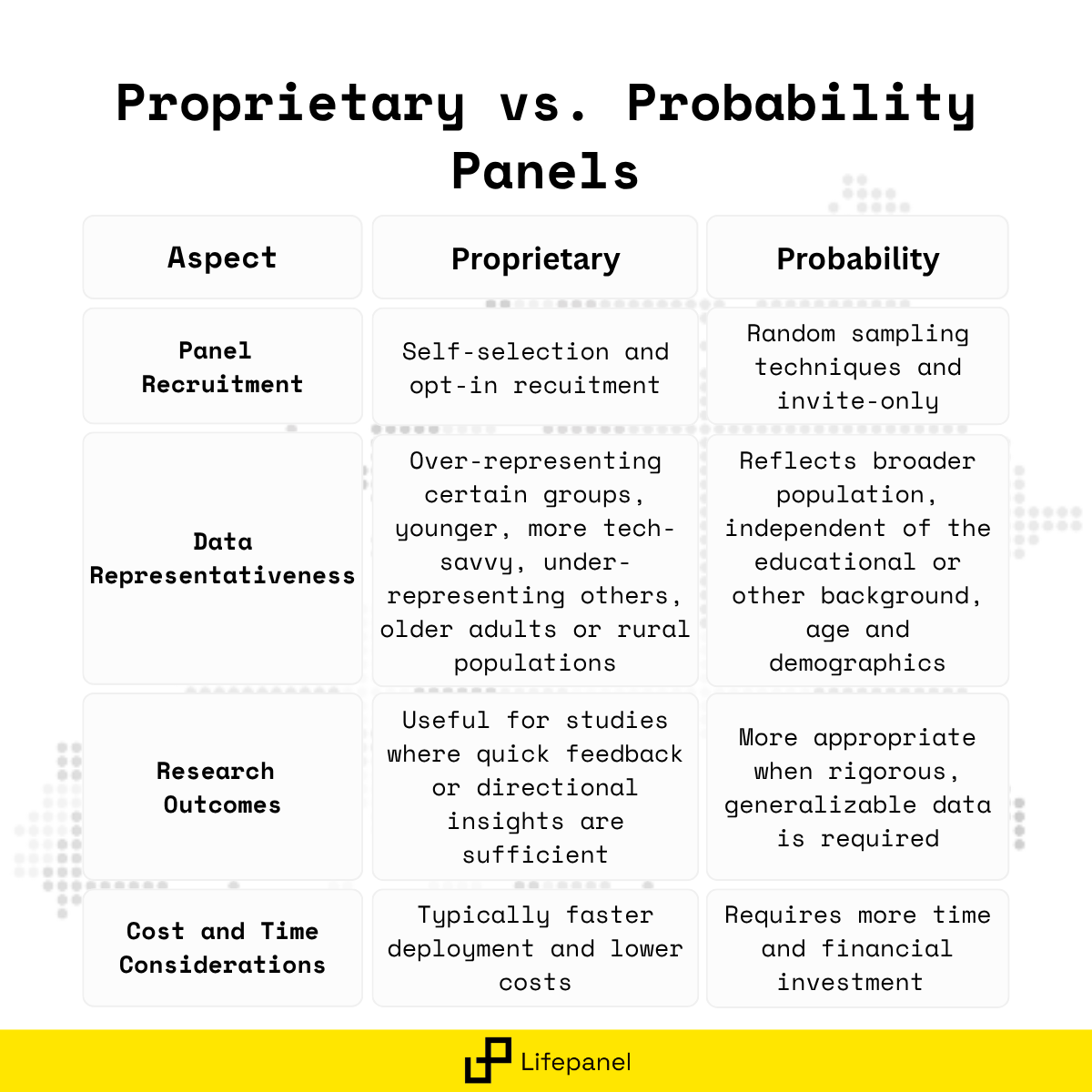When designing a research study, one of the most critical decisions you’ll make is choosing the right source of participants that will join your research, in other words, the panel. There are two main panel types you can choose, a Proprietary Panel and a Probability Panel.
The debate between a Proprietary Panel vs. a Probability Panel directly affects the reliability, accuracy, and credibility of your data and it heavily depends on the type of research you are conducting. We will cover the key differences in panel recruitment, data representativeness, and research outcomes to help you make an informed choice.
A proprietary or consumer panel is a group of survey participants maintained by a private company. Members typically join voluntarily and choose to join, often motivated by rewards or incentives such as points, gift cards, or cash. Recruitment for proprietary panels usually happens through various channels such as online advertisements, social media, and referral programs.
This method is widely used due to its speed, scalability, and relatively low cost. However, since participants self-select into the panel, it often introduces sampling bias, which may affect the generalizability of the research findings.
A probability panel is built using scientific sampling methods where every individual in the target population has a known and non-zero chance of being selected. One of the most used recruitment method for probability panels is the Random Digit Dialing (RDD), where the sample is being randomly generated by computer-aided phone number generation and participants are then matched and verified with the numbers.
At Lifepanel, our panels are built with rigorous probability-based sampling to ensure maximum accuracy and representativeness. This type of recruitment enables higher data quality and better support for population-level inference.

Main caracterictic of Proprietary Panels is the self-selection and the opt-in recuitment method. Participants are preselected or invited and actively choose to join the panel, often due to interest in rewards or frequent survey-taking. As a result, this introduces selection bias, which can skew data toward particular user types.
Probability Panels use random sampling techniques to ensure every segment of the population is fairly represented by random selection. Participants are selected based on statistical methods, which removes personal motivation from the recruitment process.
Why It Matters: If your recruitment process favors specific demographics, your results may not be generalizable to the wider population. Probability panels solve this issue by removing self-selection from the equation and ensuring a more representative sample.
Proprietary Panels often over-represent certain groups, such as younger, more tech-savvy individuals, and under-represent others, including older adults or rural populations. To mitigate this imbalance, researchers frequently apply post-stratification weighting. However, such adjustments can only partially correct for bias, especially if key subgroups are missing or underrepresented.
Probability Panels are inherently more representative because they are based on a random sampling frame. Participants are selected to reflect the broader population’s characteristics, independent of their educational or other background, age and demographics, which significantly enhances the accuracy and representativeness of the data.
Why It Matters: If your study aims to make population-level inferences, data representativeness is non-negotiable. Probability panels provide a truer picture of the broader public and are especially critical for studies influencing public policy or academic literature.
Proprietary Panels are useful for studies where quick feedback or directional insights are sufficient. For example, they are often used for:
- Quick turnaround projects where speed matters more than precision
- Exploratory research that doesn’t require population-level estimates
- Marketing campaigns that benefit from broad but non-representative feedback
- A/B testing and concept validation in commercial contexts
However, these findings may lack external validity and are often not suitable for policy-making or academic research due to inherent biases in the sample.
Probability Panels are more appropriate when rigorous, generalizable data is required. They are the preferred method for:
- Academic studies where methodology must meet publication standards
- Government and public policy research where decisions affect broad populations
- National opinion tracking that must reflect real-world sentiments
- Studies requiring high methodological standards and defensible findings
Why It Matters: The quality of your conclusions depends on the quality of your data. Probability-based panels yield results that are more credible and defensible in both academic and applied research.
Proprietary Panels typically offer faster deployment and lower costs. This makes them attractive for projects with tight timelines or limited budgets. They allow for large sample sizes in a short time, which is useful for businesses and agencies conducting routine market research.
Probability Panels, by contrast, require more time and financial investment due to the rigorous sampling and recruitment processes involved. However, the higher upfront costs are offset by the long-term benefits in data quality and reliability. These panels are an investment in research integrity.
Why It Matters: While proprietary panels might be tempting for their speed and cost, probability panels offer better value when long-term data quality is a priority. Making the right choice depends on your research goals and the trade-offs you’re willing to accept.
Choose a Proprietary Panel if you need:
Speed, efficiency, and general feedback in a short timeframe. For example, if you’re testing a new product feature or measuring brand sentiment after a campaign, proprietary panels provide a practical solution. They’re best suited for commercial use cases where statistical rigor is less critical.
Choose a Probability Panel if you need:
Accurate, representative data that stands up to scrutiny. For research that informs policy, academic theory, or strategic decisions affecting broad populations, probability panels are essential. They offer the most reliable foundation for conclusions intended to influence public understanding or action.
At Lifepanel, we believe that credible research starts with credible data. Our probability online panel is built using scientifically validated sampling frames and data collection ensuring that every member represents a segment of the broader population. The invite-only method for panel participants and the panelist verification ensures that no panelist can willingly join if not invited and they can not be part of a survey if not present in a ranomly generated sample.
This allows our clients—governments, universities, and research institutions—to base decisions on trustworthy insights, not just convenient data.
Our panels are currently active in multiple countries, each tailored to meet national standards of representativeness and methodological rigor. By combining precision with reach, we ensure your research is both robust and relevant.
The choice between a Proprietary Panel vs. Probability Panel ultimately depends on your research goals, budget, and need for representativeness. Proprietary panels offer speed and scale, but probability panels deliver on reliability and generalizability.
For research that demands accuracy and depth, a probability panel is the gold standard.

